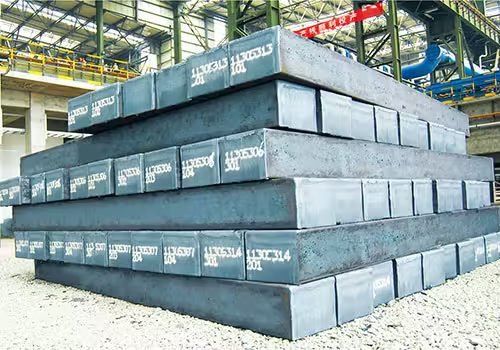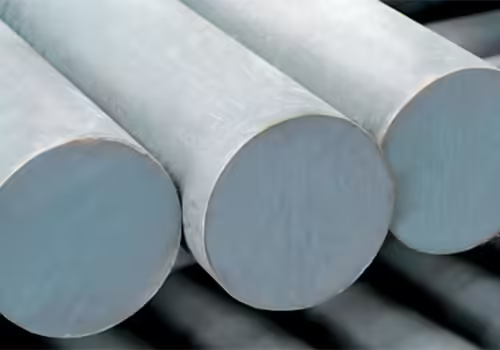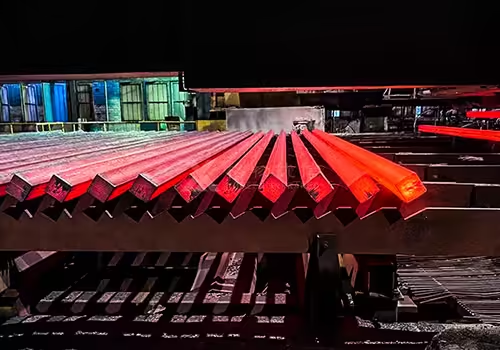
7 Crucial Steel Billet Export Warnings: The Crisis
Table of Contents
Introduction

The global steel market is currently witnessing an unprecedented shift, marked by the explosive growth of semi-finished products exports. In the first seven months of 2025 alone, the accumulated exports of steel billet saw a staggering 310% year-on-year increase. This dramatic rise has captured intense market attention, raising questions about sustainability, global trade stability, and the long-term health of the domestic steel industry.
steel billet itself is a critical product in the manufacturing chain. It is defined as a semi-finished form of steel, obtained by the primary rolling of ingots or by blooming, and serves as the essential raw material for various rolling mills that produce final products like bars, wires, and construction materials.
The reasons for this sudden boom are clear: domestically, softening demand, particularly from the real estate sector and struggling infrastructure projects, has pushed major producers, who possess the world’s most comprehensive steel industrial system, to seek opportunities abroad. While this market pivot provides short-term gains due to superior cost competitiveness, it simultaneously exposes the industry to profound and accumulating risks—the very foundation of the looming steel billet crisis.
Why the Sudden Pivot to Steel Billet?
The strategic shift towards exporting steel billet is multifaceted, driven by both market dynamics and regulatory avoidance.
The Cost-Competitive Edge
With a massive annual production capacity exceeding 1.068 billion tons, accounting for over 53.4% of global output, the steel industry has achieved significant economies of scale. This scale, combined with pricing strategies, ensures the resulting steel billet often offers a competitive price advantage compared to counterparts in regions like the Commonwealth of Independent States (CIS) or Turkey. For example, August 2025 saw CIS steel billet quoted at $460 per ton (CFR China). This price advantage creates significant profit margins, motivating companies to prioritize export orders.
Evading Existing Trade Barriers
A major driver behind the steel billet surge is the increasing global protectionism facing finished steel products. Since January 2024, nearly a hundred foreign anti-dumping and countervailing duty investigations or rulings have targeted steel products. Traditional exports like hot-rolled and cold-rolled products are under severe strain due to factors such as the implementation of the EU carbon border adjustment mechanism (CBAM) and rising anti-dumping tariffs in Southeast Asia. Countries like Vietnam and South Korea have imposed anti-dumping duties on finished steel.
In response, exporters are turning to steel billet, a semi-finished commodity that typically faces fewer, if any, restrictive tariffs. Major destinations, including Indonesia, Turkey, and Saudi Arabia, impose high tariffs on some finished steel products but allow steel billet imports duty-free, making the material an attractive alternative for overseas rolling centers.
The 7 Crucial Warnings and Looming Crisis

The rapid growth in steel billet exports is generating severe friction points, signaling a potential trade crisis that could deepen the challenges faced by the industry.
Warning 1: Anti-Dumping Investigations Targeting Steel Billet
The most immediate threat is the direct targeting of steel billet by overseas governments. The protectionist backlash is already spreading from finished products to semi-finished goods. As early as June 20, 2025, Pakistan’s National Tariff Commission initiated a second sunset review for anti-dumping duties on continuously cast square steel billet following applications from domestic producers. If this trend continues, major destinations like Indonesia, the Philippines, or Saudi Arabia may follow the examples of Vietnam and South Korea and launch their own investigations against steel billet.
Warning 2: Export Bans and Restrictions
Some nations are moving beyond tariffs to outright bans to protect their domestic processing capabilities. In May 2025, Kazakhstan proposed a six-month export ban on steel billet. This temporary restriction is explicitly aimed at stimulating domestic processing of raw materials to produce higher value-added finished products, thereby enhancing local economic strength and reducing reliance on finished steel imports. Such measures by major trading partners could severely limit market access.
Warning 3: Domestic Industry Pressure for Export Limits
The crisis isn’t only external; influential domestic voices are also calling for restrictions. In June 2025, the China Iron and Steel Association (CISA) proposed that relevant national ministries restrict steel billet exports. CISA argued that the massive outflow of this semi-finished product wastes rich domestic deep processing capacity, consumes non-renewable energy and resources, generates pollution and carbon emissions, hinders industrial upgrades, and exacerbates low-level market competition.
Warning 4: Global Trade Protectionism Spreading
The current trade relief actions are a retaliation against perceived excess capacity and low-price dumping. Should the flood of steel billet continue, there is a risk of concerted investigations or the expansion of anti-dumping scopes by relevant countries, including major economic blocs like the US and the EU, which have already limited transshipment trade multiple times. This systemic risk threatens to pull the steel sector into deeper difficulties.
Warning 5: High Inventory Constraining Prices
Domestic market fundamentals also contribute to the crisis atmosphere. Despite the surge in exports, high inventory levels are putting downward pressure on prices. A survey on August 28, 2025, showed that the total steel billet warehouse and port inventory across six major cities reached 1.4849 million tons, marking a new high for the year. The inventory buildup is primarily due to reduced actual demand as downstream rolling mills implement environmental production limitations, leading to passive accumulation.
Warning 6: Narrowing Profit Margins
Market conditions in the late summer of 2025 showed signs of strain. While upstream raw materials, particularly coke, saw price increases, pushing up the average taxed cost of steel billet to 2963 CNY/ton, the price of the product struggled to keep pace. As of August 31, 2025, the average profitability for steel mills in the core Tangshan region was only 7 CNY/ton, a significant monthly decrease. The lack of strong downstream demand and the low market activity limited the revenue space for steel enterprises.
Warning 7: Wasting Domestic Deep Processing Capacity and Environmental Cost
The final warning relates to the long-term detriment to national industrial policy. By exporting steel billet—the raw material—the country forfeits the opportunity to export higher value-added products that would utilize its advanced downstream capabilities. Companies like Henan Jiyuan lron & Steel (Group) Co., Ltd., founded in 1958, specialize in high-quality steel production, including round bars, square bars, and precision processed steel. The focus on exporting raw steel billet bypasses this technological capability and transfers the inevitable environmental burden (pollution and carbon emissions) elsewhere.
Key Steel Billet Export Destinations (2022-2025)

The table below illustrates the destinations that have been crucial in absorbing the massive export volumes of steel billet, demonstrating the reliance on markets that currently offer tariff relief for the semi-finished product.
| Country | 2022 (10,000 Tons) | 2023 (10,000 Tons) | 2024 (10,000 Tons) | 2025 (Jan–Jul) (10,000 Tons) | Primary Role |
| Indonesia | 85 | 31 | 191 | 115 | Local infrastructure/rolling |
| Philippines | 16 | 51 | 53 | 99 | Local infrastructure/rolling |
| Turkey | 5 | 56 | 65 | 65 | Gateway to EU market/Processing |
| Italy | 3 | 47 | 16 | 59 | Gateway to EU market/Processing |
| Saudi Arabia | 0 | 0 | 40 | 53 | Local construction projects/Processing |
| Thailand | 1 | 17 | 22 | 4 | Local infrastructure/rolling |
| Total Exports | 103 | 332 | 863 | 747 | Massive overall growth |
Data Source: General Administration of Customs
As shown, exports have escalated rapidly, particularly to nations where the material is often processed into finished goods for local infrastructure or used as a critical window to access other markets, such as the EU.
Technical Context: What Defines Quality Steel Billet?

The complexity of the steel billet trade is also tied to stringent technical specifications. steel billet is available in various cross-sections, including square, round, flat, rectangular, and shaped, with the chosen form correlating directly to the final product being rolled. For instance, round steel billet is the raw material used for seamless pipe production.
Maintaining quality is paramount. Cross-sectional dimensions must meet requirements for rolling deformation and finished product quality, while also respecting constraints imposed by roll strength and bite conditions.
Standard technical requirements define precise parameters for the material, including:
• Thickness range (e.g., 150-240mm with tolerances).
• Length range (e.g., 3700-10000mm with tolerances).
• Specific cross-sectional dimensions (e.g., 152*170mm).
• Strict allowances for cross-sectional and length tolerances.
Companies often leverage strong technical capabilities to ensure their steel billet meets these global standards. Henan Jiyuan, for example, highlights its technical center and processing service capabilities, which include tech support, inspection services, and specialized processing.
Conclusion
In the short term, the massive export of steel billet appears justified, offering a necessary pressure relief valve for domestic capacity and providing companies with export orders. However, the seven crucial warnings—from aggressive anti-dumping actions and regional bans to domestic calls for restrictions and high inventory—suggest that this path is becoming unsustainable.
Long-term stability requires a shift away from high-volume, low-value semi-finished goods. The coming month of September is anticipated to involve a complex interplay of factors: while inventory pressure remains high, supply contraction (due to expected environmental limits) and rising raw material costs could lend temporary upward support to the steel billet market, potentially leading to a volatile but overall stable-to-strong trend. Nevertheless, the fundamental risks associated with trade protectionism and inventory overhang remain the dominant forces shaping the steel billet crisis.
FAQ
Q1: What is the primary use of steel billet?
A: The material is primarily used as the raw material for various types of rolling mills. It is rolled into many different finished steel products, such as flat steel, angles, beams (I-beams, channels), and bars, which are then used in construction and manufacturing.
Q2: Why is the export of steel billet considered problematic by some industry analysts?
A: While exports bring revenue, industry analysis suggests the aggressive export of the semi-finished product is detrimental in the long run. It results in the consumption of domestic resources and energy, generates pollutants, and bypasses the use of sophisticated domestic deep-processing facilities, thus hampering the overall industrial upgrade toward higher-value products.
Q3: What quality control processes are relevant to steel billet?
A: Quality control for the material is extremely strict. Specifications cover precise dimensions (e.g., 64*64mm, 152*170mm cross-sections) and tolerances for thickness, width, length, and cross-sectional diagonal. Leading manufacturers often provide comprehensive inspection services and technical support to ensure compliance with these exacting standards.
Q4: How is the current price of steel billet trending?
A: As of late August 2025, the domestic price of steel billet was generally experiencing a weak adjustment, with the Tangshan factory price reported at 2970 CNY/ton. This downward trend was influenced by weakening terminal demand and softening raw material costs, though anticipated supply contraction offered some stage-specific bottom support.






